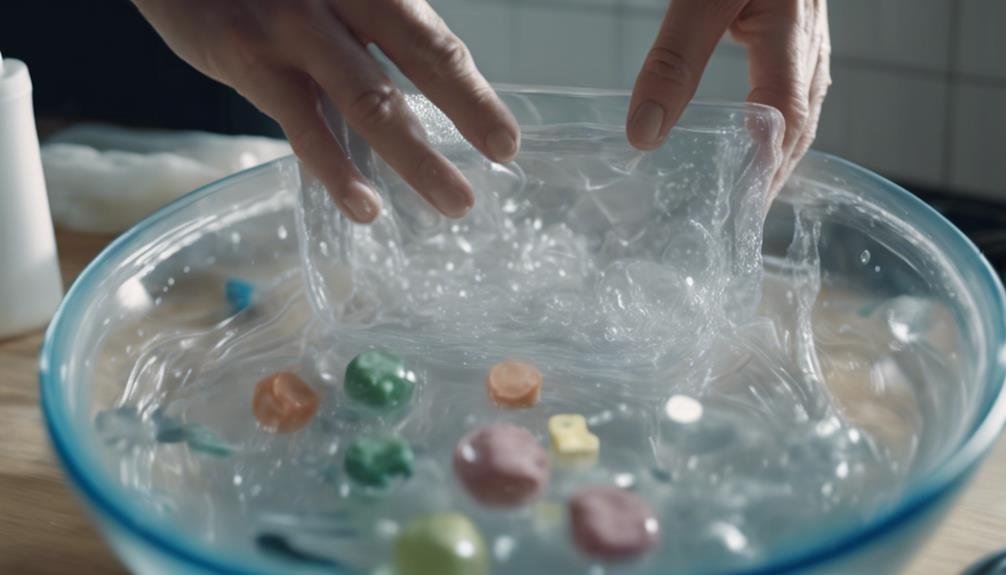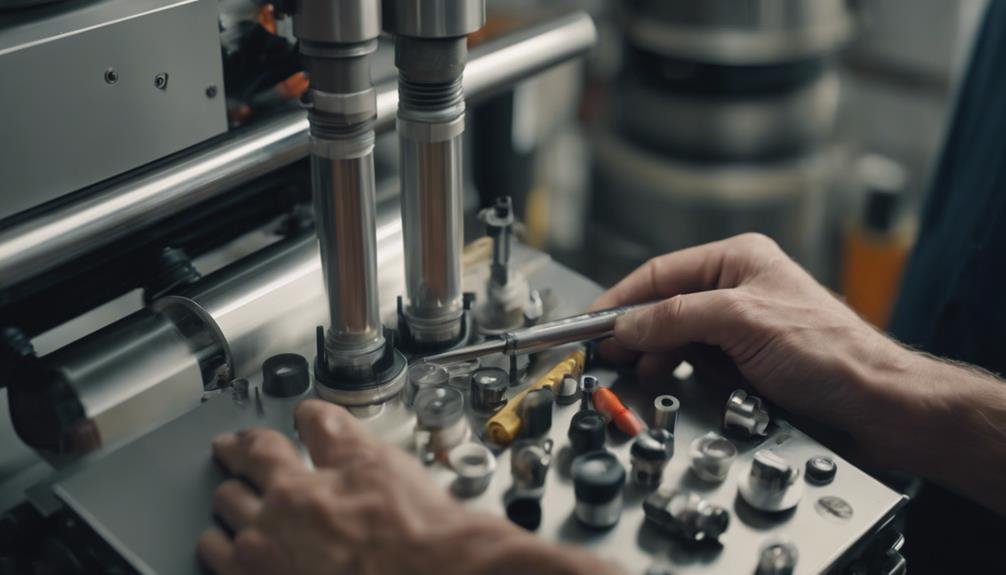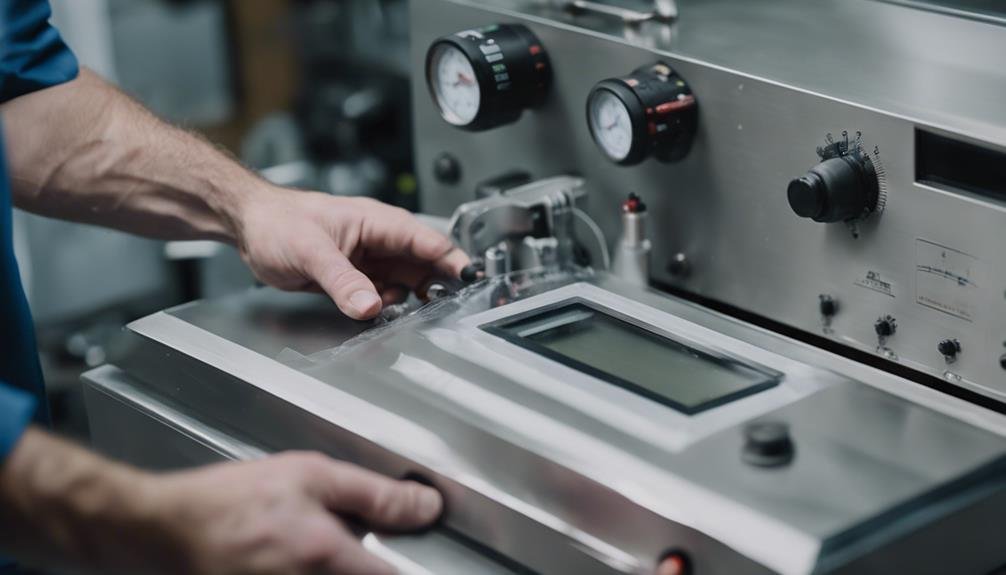If your vacuum sealing machine is experiencing leaks, start by observing signs like reduced vacuum pressure, longer sealing durations, or unusual hissing noises. Check the bellows and pistons for any signs of damage or wear. Run a vacuum cycle and inspect for air bubbles in water to detect the source of the leaks. Ensure all seals are secure and in good shape. Address any issues with air intake, adjust the seal pressure, and adhere to maintenance recommendations. Perform a leak test by pressurizing the chamber and using indicators to confirm airtightness. This step is crucial for efficient machine operation and preserving product quality. For a detailed guide on mastering these checks, continue exploring.
Identifying Common Leak Symptoms
When identifying common leak symptoms in vacuum sealing machines, you'll notice decreased vacuum pressure, longer sealing times, and visible air bubbles in the sealed package. These symptoms are telltale signs that something isn't quite right with your machine. Decreased vacuum pressure often means that air is sneaking into the system, preventing the machine from creating that perfect seal you're aiming for.
You'll also hear unusual hissing sounds during the sealing process, which can indicate air escaping from the system. This noise is a red flag that your machine may have a leak. Pay attention if you notice that the overall efficiency of your vacuum packaging machine has dropped. This decline often signals a leak that needs immediate attention.
Another clear symptom is when your packages don't hold their vacuum seal or show signs of re-inflating shortly after being sealed. Leaks in the machine are commonly the culprit here. Detecting these issues and acting swiftly to fix them is essential. By doing so, you'll maintain product integrity and extend shelf-life, ensuring your vacuum sealing machine operates at peak performance.
Inspecting Bellows and Pistons
To guarantee your vacuum sealing machine operates efficiently, start by meticulously inspecting the bellows and pistons for any signs of leaks. Leaks in these components can result in poor seal pressure, compromising the quality of your vacuum sealing. Follow these steps to make sure your machine is in top condition:
- Run a Vacuum Cycle: Initiate a vacuum cycle and observe the bellows and pistons closely. If air is being sucked into the bellows, it indicates a leakage issue that needs addressing.
- Visual Inspection: Carefully examine the bellows and pistons for any visible cracks, tears, or wear. Even minor damage can affect the seal quality, so it's important to be thorough.
- Check Seal Integrity: Make certain that all connections involving the bellows and pistons are tight and secure. Loose fittings can lead to air leaks, impacting the machine's performance.
Performing a Water Test

Submerge the bellows or pistons in water to easily spot leaks as bubbles form, indicating a problem area. This simple water test can help you pinpoint the exact location of the leak in your vacuum sealing machine. Start with a clear container filled with water. Carefully place the bellows or pistons inside and watch for bubbles. If you see bubbles rising, you've found a leak.
Here's a quick reference table to guide you through the water test process:
| Step | Action |
|---|---|
| 1 | Fill a clear container with water. |
| 2 | Submerge bellows or pistons in water. |
| 3 | Observe for any bubble formation. |
| 4 | Identify the exact location of leaks. |
| 5 | Mark problem areas for repair. |
The bubbles indicate that air is escaping, which is the root of poor seal pressure. Knowing the exact location of the leak helps you address the issue more efficiently. Remember, this water test is straightforward but essential for ensuring your vacuum sealing machine operates effectively. Don't skip it if you want to maintain strong, reliable seals in your vacuum-sealed packages.
Running a Vacuum Cycle
Running a vacuum cycle allows you to pinpoint and address leaks in your vacuum sealing machine's bellows or pistons. When you run a vacuum cycle, you can observe the machine's performance and identify any inconsistencies in the seal pressure. A properly functioning vacuum cycle is important because it guarantees that your machine maintains its efficiency and reliability.
Here's a simple process to follow:
- Initiate the Vacuum Cycle: Start by activating a vacuum cycle on your machine. Pay close attention to how quickly and effectively the vacuum is created.
- Monitor for Air Intake: Listen for any unusual sounds and feel for any air being sucked into the bellows. If you notice air entering during the cycle, it indicates a potential leak.
- Inspect the Bellows and Pistons: After the cycle, inspect the bellows and pistons closely. Leaks often manifest as tiny bubbles or hiss sounds during the vacuum cycle.
Regularly running vacuum cycles will help you detect and address any leaks affecting the sealing process. By staying vigilant and performing these checks, you can make sure that your vacuum sealing machine remains in top working condition and continues to produce reliable seals.
Addressing Air Intake Issues

After running a vacuum cycle to detect leaks, you should focus on addressing any air intake issues that you've identified. Air intake problems can lead to compromised packaging integrity, so it's important to tackle them right away. Start by checking for any leaking seals. A good seal is essential to maintain the vacuum inside the package. If the seal looks damaged or worn out, replacing it can often solve the problem.
Next, inspect other components of your vacuum sealing machine. Damaged parts like hoses or valves can also allow air to enter, undermining the vacuum process. Regularly inspecting and maintaining these components can prevent many air intake issues before they become serious.
Improper machine maintenance is another common cause of air intake problems. Make sure you're following the manufacturer's maintenance guidelines. Clean the sealing area and other critical parts regularly to ensure a good seal every time you use the machine.
If you're unable to resolve the air intake issues yourself, don't hesitate to seek professional help. A qualified technician can diagnose and fix more complex problems, ensuring your vacuum sealing machine operates at peak performance. Addressing these issues promptly will keep your packaging secure and effective.
Ensuring Seal Integrity
Why is guaranteeing seal integrity so crucial for the effective operation of your vacuum sealing machine? Simply put, a strong seal ensures that your products remain fresh and free from external contaminants. Without seal integrity, the vacuum can't properly maintain its hold, leading to compromised preservation.
To achieve this, focus on three critical aspects:
- Proper Seal Pressure: Guarantee your machine applies the right amount of pressure. Leaking bellows or pistons can lead to poor seal pressure, so inspect these components regularly. Testing the bellows under water can help identify leaks.
- Seal Time and Wire Thickness: Adjust the seal time and use the correct wire thickness for your bags. Too short a seal time or an inadequate wire can result in weak seals.
- Bag Placement: Ensure your bags are placed correctly in the sealing area. Misaligned bags can cause incomplete seals, allowing air to enter.
Monitoring these elements helps maintain seal integrity. If air is being sucked into the bellows during a vacuum cycle, you've got a leak that needs immediate attention. By addressing these areas, you enhance the reliability and efficiency of your vacuum sealing machine.
Conducting Final Leak Tests

Conducting final leak tests is vital for guaranteeing your vacuum sealing machine operates efficiently and maintains product integrity. To perform these tests, you'll need to pressurize the chamber and closely monitor for any drop in pressure. A stable pressure reading indicates a successful seal, while a drop suggests a leak that needs attention.
Consider using leak detection tools like leak flow indicators. These devices can help you pinpoint the exact location of any leaks, making it easier to address them promptly. Conducting final leak tests is essential before packaging products, as it helps to identify and fix leaks, thereby preventing product contamination and ensuring packaging integrity.
Here's a quick look at the steps involved:
| Step | Action | Purpose |
|---|---|---|
| 1 | Pressurize the chamber | Create a test environment |
| 2 | Monitor pressure | Check for stability |
| 3 | Use leak flow indicators | Pinpoint leak locations |
| 4 | Fix identified leaks | Ensure product safety |
Conclusion
You've now got the tools to fix leak problems in your vacuum sealing machine like a pro. By identifying symptoms, inspecting parts, and performing various tests, you'll guarantee your machine runs smoothly. Think of it like tuning an instrument; each step brings you closer to a perfect seal. Don't rush, take your time, and you'll have your machine performing flawlessly. Remember, a well-sealed machine means longer-lasting freshness for your products.
